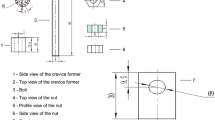Abstract
The electrochemical behavior of 316L stainless steel was investigated in acid chloride environments, and pitting potentials were determined electrochemically and chemically. An increase in the anodic maximum current density was observed upon decreasing the cathodic potential from which the scan was initiated to determine the polarization curve. To determine the critical pitting potential through the chemical method, the potential was increased by increasing the concentration of ferric ions in ferric chloride while holding the chloride ion concentration constant with sodium chloride. When 316L stainless steel was immersed in 15 g/1 of FeCl36H2O containing the same chloride ion concentration as 5% NaCl with pH=2 at 57°C, the corrosion potential increased to 0.47 V (SHE) within two minutes due to initial passivation. Immediately after reaching 0.47 V (SHE), which was just above the pitting potential of 0.45 V (SHE) determined electrochemically in 5% NaCl (pH=2, 57°C), the corrosion potential continuously decreased, indicating the onset and propagation of pitting corrosion. A correlation between the electrochemical and chemical methods can be verified if the proper measurements are made and the observations are properly interpreted.
Similar content being viewed by others
References
W. D. France, Jr. and N. D. Greene, Corrosion,26, 1 (1970).
R. J. Brigham, Corrosion,26, 200 (1970).
B. E. Wilde and E. Williams, J. Electrochem. Soc.,116, 1539 (1969).
B. E. Wilde and E. Williams, J. Electrochem. Soc.,117, 775 (1970).
I-S. Lee, E. E. Stansbury and S. J. Pawel, Corrosion,45, 134 (1989).
M. J. Johnson, Localized corrosion-Cause of metal failure, ASTM STP516, 262, (1972).
C. L. McBee and J. Kruger, Electrochimica Acta,17, 1337 (1972).
G. Okamoto and T. Shibata, Passivity of Metals, 646, The Electrochemical Society, (1978).
A. P. Bond and E. A. Lizlovs, J. Electrochem. Soc.,115, 1130 (1968).
R. J. Brigham and E. W. Tozer, Corrosion,29, 33 (1973).
B. E. Wilde and E. Williams, J. Electrochem. Soc.,118, 1057 (1971).
A. Broli, H. Holtan, and K. Prestrud, Corrosion,30, 427 (1974).
P. E. Manning, Corrosion,36, 468 (1980).
Z. Szklarska-Smialowska and M. Janik-Czachor, Corrosion Science,11, 901 (1971).
Z. Szklarska-Smialowska, Corrosion,27, 223 (1971).
B. E. Wilde, Localized Corosion: NACE-3, 342 (1974).
R. F. Steigerwald, Corrosion,22, 107 (1966).
Author information
Authors and Affiliations
Rights and permissions
About this article
Cite this article
Lee, I.S. Interpretation of electrochemically and chemically investigated corrosion behaviors of 316L SS in acid chloride environments. Metals and Materials 3, 144–151 (1997). https://doi.org/10.1007/BF03026139
Issue Date:
DOI: https://doi.org/10.1007/BF03026139




